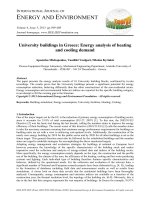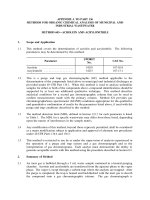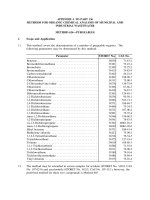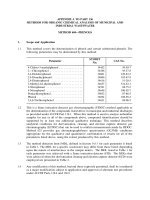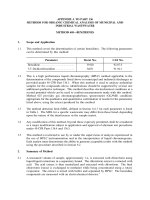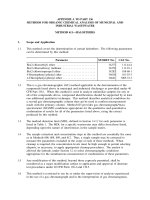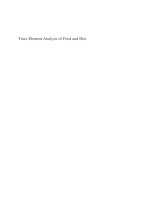Comparative analysis of LDPC and BCH codes error-correcting capabilities
Bạn đang xem bản rút gọn của tài liệu. Xem và tải ngay bản đầy đủ của tài liệu tại đây (279.75 KB, 5 trang )
5
UDC 621.391
COMPARATIVE ANALYSIS OF LDPC AND BCH CODES
ERROR-CORRECTING CAPABILITIES
Leonid O. Uryvsky, Serhii O. Osypchuk
Telecommunication Networks Department Institute of Telecommunication Systems National Technical
University of Ukraine “KPI” Kyiv, Ukraine
The error-correcting capabilities of regular LDPC (Low Density Parity Check) codes and BCH (Bose-ChaudhuriHocquenguem) codes are examined. The qualitative analysis and the quantitative assessment of error-correcting abilities are
performed for LDPC codes with code word length n=1000 bits and BCH codes with code word length n=1023 bits. The code
rates of LDPC and BCH codes are determined for a known signal to noise ratio in the gaussian channel; detected code rates are
optimal for predefined modulation type and required information reliability on the receiver side.
Introduction
Significant interest has raised for LDPC (Low Density Parity Check) codes recently. The importance of
LDPC codes is shown by different standards and recommendations, where LDPC codes are used: DVB-S2,
IEEE802.16 et al. [1]. Theoreticians and practices in error control coding area renewed a level of interest to
LDPC codes over the world. Many scientific publications devoted to LDPC: [2-4] (Great Britain), [5]
(USA), [1] (Japan) and others.
LDPC codes are block structured linear divisible
codes. The LPDC codes are introduced for the first by
R. Gallagher in 1962 [6], but interest was not attracted
to them so much at that time. These codes have been
forgotten for several tens of years. Here is the next explanation [7] of the reason why LDPC codes exploration was held up after Gallagher’s publications and resumed in 1998. Turbo codes were discovered in the
middle of 1990 and have iterative decoding procedures
with attractive error-correcting characteristics; whereas
LDPC codes have iterative decoding procedures as well
[8], an interest was aroused for these codes too. It was
assumed that LDPC codes stand as well closely to
Shannon limit as turbo codes, and this was corroborated
in relevant researches [2, 7].
BCH codes (Bose-Choudhury-Hocquenguem), in
turn, are one of the best block codes. The characteristics
of BCH codes are shown in [9].
The goal of this research is LDPC and BCH codes
comparison. Criteria for comparison are the next: identical code word length, equal shift keying manipulation,
known channel parameter SNR (Signal to Noise Ratio),
same required bit error probability on the receiver end.
Problem statement
The entry parameters for task are below:
– Channel parameter: SNR = 0…14 dB;
– Shift keying manipulation: QPSK;
– Code word length for antinoise coding: n=1000 for
LDPC codes and n=1023 for BCH codes;
– Requirement to the bit error reliability on the receiver side: 10-6.
Output parameters are LDPC and BCH coding rates:
RLDPC and RBCH. To reach the goal of research, the antinoise code rates RLDPC and RBCH are found to achieve
required information reliability on the receiver side if
the described entry parameters above are known; given
code rate values are compared and the best errorcorrecting method {LDPC, BCH} on the criterion
{RMAX, dMAX} is chosen. This task can be schematically
presented as shown on the Fig. 1.
So, the main task is a search of antinoise code with
maximal code rate R and code distance d values, and
this is a fundamental problem of coding theory [10].
h2=const, dB
QPSK
рbit=10-2
LDPC: n=1000
BCH: n=1023
pbit_req=10-6
{Rmax,dmax}
h2=const, dB
QPSK
pbit_req=10-6
R{LDPC, BCH} – ?
Fig. 1. Statement of the problem
The next subtasks were set up to achieve the goal:
– Development and implementation the search procedure of minimal LDPC code distance when the code
length and check matrix parameters are predefined;
– Determination of positions the LDPC and BCH codes
points in coordinates R = f (d/2n);
ISSN 2312-4121, Information and Telecommunication Sciences, 2014, Volume 5, Number 1
© 2014, National Technical University of Ukraine “Kyiv Polytechnic Institute”
6
INFORMATION AND TELECOMMUNICATION SCIENCES VOLUME 5 NUMBER 1 JANUARY ─ JUNE 2014
– Definition the maximum antinoise code rate that is
able to provide required bit error reliability.
LDPC and BCH
codes characteristics
BCH codes are characterized by the possibility to
form the antinoise code with predefined errorcorrecting abilities such as minimal code distance d.
The BCH code exists for any values m and t=(d-1)/2
with code length n=2m–1 that corrects all combinations
of t or less errors number; this code has mt corrective
bits in the code word. Thus, the BCH code length can
not be chosen randomly and depends from the parameter m; BCH code length always has an odd value. The
properties of some BCH codes with parameter m=10
and code length 210–1=1023 are shown in the Table I.
TABLE I.
n
1023
1023
1023
1023
k
1003
993
983
973
1023
1023
1023
1023
783
773
763
753
1023
1023
1023
1023
1023
243
233
223
213
203
BCH CODES
n-k=mt
20
30
40
50
...
240
250
260
270
...
780
790
800
810
820
t
2
3
4
5
R
0.98
0.97
0.96
0.95
24
25
26
27
0.77
0.76
0.75
0.74
78
79
80
81
82
0.24
0.23
0.22
0.21
0.20
W
n − n ⋅ c − (Wc − 1)
Wr
= 1 − Wc + Wc − 1
R=
n
Wr
n
As follows from example, BCH code with code
length n=1023 can be formed with code rate step 0.01.
Herewith the BCH code rate decreases linearly whereas
error-correcting capability increases:
R = 1 − 0,0097t , or
(1)
t=
1− R
0, 0098
It is shown in [11] that regular LDPC codes more often demonstrate better characteristics than non-regular
LDPC codes. It’s shown in [2] that regular LDPC codes
have better properties in Gaussian channel than nonregular LDPC codes. Together with this, the conditions
are presented in [5] when non-regular LDPC codes
have better characteristics actually. Thereby, either regular LDPC codes or non-regular LDPC codes are entitled to existence in the theory and practice of antinoise
coding.
Forming of regular LDPC codes is defined in consecutive order. Regular LDPC code with a code length
n forms based on the check matrix H. Сheck matrix H
has a fixed value of “ones” in the matrix row Wr and a
fixed value of “zeros” in the column Wc [2]. It’s considered that check matrix H has a low density of “ones”
when density of “ones” in check matrix H is less than
50% of all the check matrix elements.
The LDPC code error-correcting ability is specified
based on specific parameters of check matrix H: n , Wr ,
Wc . At the same time, positions of “ones” in the check
matrix Н are based on random permutations the basic
sub matrix H1 columns. Each column of basic sub matrix H1 includes only solus “one”. The regular LDPC
code rate is defined as a function of check matrix H parameters (3):
(2)
Inaccuracy of (1) and (2) is lower than 2.2%.
Let’s turn to the LDPC codes characteristics. LDPC
codes are not analytical and this is one of the differences from BCH codes. LDPC code properties cannot
be defined analytically as a result of this.
A lot of LDPC code modifications exist, and most of
them are not explored in full. Together with this, all
LDPC codes are classified by two groups: regular and
non-regular. These two groups are differentiated by the
check matrix construction that used for encoding and
decoding code words. Non-regular LDPC codes are
built based on regular LDPC codes [8].
(3)
Withal, LDPC codes check matrices Н with the
same matrix parameters, but different positions of
“ones” in check matrix, can generate antinoise codes
with different code distances and respectively different
error-correcting abilities. Hence the task raises to search
the best check matrix H with known parameters n , Wr ,
Wc by the criterion of maximal error-correcting ability
of LDPC code: tmax ≤ ( d max − 2 ) / 2 .
LDPC code check matrix H can be represented as:
H1
(
H
)
π
1
1
H =
M
π
(
H
)
WC −1 1 ,
(4)
Where Н1 – basic submatrix, π i ( H1 ) – submatrices
are generated by random rearrangement of basic submatrix columns Н1, i=1,2,…,Wc–1.
Check matrix H can be transformed into the matrix
form:
H = [ A | In−k ] ,
(5)
URYVSKY L., OSYPCHUK S.: COMPARATIVE ANALYSIS OF LDPC AND BCH CODES ERROR-CORRECTING CAPABILITIES
Where A – some non-sparse fixed matrix with “zeros”, “ones” and dimensions ( ( n − k ) × k ) ; I n − k – identity matrix with dimensions ( n − k ) × ( n − k ) . The generation matrix G can be represented as:
G = I k | − AT
(6)
If the check matrix Н is presented as (5), then the
generation matrix G (6) can be simply given from the
matrix Н by transformation.
The matrix G is also named as generative matrix so
far as code words that can be represented as linear combinations of matrix G rows. The matrices Н and G are
related as [2]:
GH T = 0, HG T = 0
(7)
Code distance d for regular LDPC code is defined as
the least columns number of check matrix H that overall
gives 0. The analytical description for LDPC code error-correcting abilities doesn’t exist so far; however, the
forward and backward theorems exist for LDPC code
distance [10].
Theorem 1. If any l ≤ d – 1 columns of linear code
check matrix Н are linearly independent, then a minimal code distance will be at least d. If d linearly independent columns are found, then minimal code distance
is equal d.
Theorem 2. If minimal code distance is equal d, then
any
l ≤ d – 1 columns of check matrix H are linearly independent and exactly d linearly independent columns exist.
Thus, it’s possible to conclude from theorems 1 and
2 that LDPC code distance d can be identified from matrices H and G as the next: the d value equals the least
columns number of matrix Н that sum up to 0; the d
value equals the least row weight (the number of ones
in the row) in matrix G.
The LDPC codes error-correcting ability is researched in current work based on the described properties of check and generating matrices. The same LDPC
code word length n=1000 and different check matrix H
parameters result in different antinoise code rates R and
different numbers of corrected errors per code words respectively. Given results in experiments are compared
with error-correcting abilities of BCH codes with code
word length n=1023 bits.
LDPC codes error-correcting ability
Known methods for LDPC code distance d search
complexity grows exponentially as is shown in [2].
Known search methods give a possibility to define the
code distance value for codes with code length less that
n<1000 bits in terms of spending sensible time resources for a search. The LDPC code error-correcting
7
value can be found from matrices H and G by search,
but the given code distance value can be not the best for
used LDPC matrix parameters.
The study of LDPC code error-correcting abilities
with code length n=1000 bits is performed in this work
based on the theorems 1 and 2. This idea is shown on
Fig. 2.
The line #1 (Fig. 2) indicates the code distance d
search complexity when use only theorem 1 (by using
matrix Н); the line #2 designates a code distance d
search complexity when use only the theorem 2 (by using matrix G). The “complexity” term means in this
context the number of elementary operations to execute
in the specific time point and save the same progress of
the end results receiving.
Fig. 2. A graphical representation of application
the theorems 1, 2 for code distance search process
The point A (Fig. 2) indicates the moment when it’s
better to use theorem 1 before that, but it’s better to use
theorem 2 after point A. The point A corresponds the
case when code distance d = 6 (t = 2) is found by theorem 1. As soon as the matrix Н has d = 6, then search
by theorem 1 stops and further search of code distance
d continues by reduction the matrix H to matrix G in
canonical form (5). Thus, the minimal time for search
LDPC code distance spends if combine theorems 1, 2
for the search process.
The described algorithm above for LDPC code distance search is implemented on Java language. LDPC
code distance results for n=1000 are obtained from set
of numerical experiments performed on high performance computing cluster in NTUU “KPI”. Matrix H
and found LDPC code error-correcting parameters are
presented in Table II.
8
INFORMATION AND TELECOMMUNICATION SCIENCES VOLUME 5 NUMBER 1 JANUARY ─ JUNE 2014
n
1000
1000
1000
1000
1000
GIVEN PARAMETERS OF LDPC CODES
Wr
100
100
100
100
100
Wc
10
20
30
40
50
k
909
819
729
639
549
R
0.91
0.82
0.73
0.64
0.55
d
22
40
64
98
138
t
10
19
31
48
68
LDPC and BCH
codes comparison
The method for search the best antinoise block
code by criterion of maximal approach to the Shannon
limit is described in [9]. This method implies the block
code selection with using up-to-date theory of antinoise coding. This method is used for calculation and
error-correcting abilities comparison of LDPC and
BCH codes. Regarding the method [9] and problem
statement (Fig. 1), the next factors can be noted: 1) if
the manipulation QPSK is used, then an initial bit error probability pbit=10-2 is reached when the signal to
noise ratio in the channel is h2=7.3 dB; 2) if antinoise
block code with code length n=1000 bits is used and
required reliability is pbit_req =10-6, then it’s needed to
correct up to t=28 errors [9]. Only in this case the required reliability pbit_req =10-6 can be achieved on the
receiver side; 3) to satisfy the required reliability
pbit_req =10-6, the value d/2n for antinoise code should
meet 0.03.
The limit conditions of antinoise codes existence
with some error-correcting abilities are described by
Plotkin limit [10]. A sufficient condition for antinoise
codes with specific error-correcting abilities is defined
by the Varshamov-Gilbert limit (VG). Thereby, the
Plotkin and VG criteria provides an opportunity to
compare different error-correcting block codes in the
same relative coordinates R = f (d/2n) for assessment
the error-correcting capabilities.
The dependency R = f(d/2n) is shown on the Fig. 3.
The Plotkin and VG limits are shown in these coordinates. The positions of some BCH (Table I) and given
experimentally LDPC codes (Table II) are plotted on
Fig. 3 with code rates 0,55…0.9. If take into account the
code length n ~ 1000 bits and set the value d/2n=0.03,
then the triangle between Plotkin and VG limits shows
the shaded area (Fig. 3) which outlines the region of antinoise codes parameters that can provide expected reliability pbit_req=10-6 [9]. If compare the characteristics of
BCH codes with n=1023 bits and LDPC codes with
n=1000 bits, then it’s possible to say that the next code
rates fit the ratio d/2n=0.03: RBCH=0.7 and RLDPC=0.73.
If RBCH=RLDPC=0,55, then d/2nBCH=0,05 a nd
d/2nLDPC=0,07. The above two instances demonstrate a
better correcting capabilities of LDPC codes in comparison
with
BCH
codes
(RLDPC>RBCH
if
d/2nLDPC=d/2nBCH=const; or d/2nLDPC>d/2nBCH when
RLDPC=RBCH; or dLDPC>dBCH when n=const).
If continuously change the parameter h2, then it’s
possible to get dependency R=f(h2) (Fig. 4). Both
Plotkin and VG limits are stood below the Shannon
limit in coordinates R=f(h2). Consequently, if channel
parameter h2, current bit error probability pbit, required
reliability pbit_req are known, then it’s not possible to
come to Shannon limit nearer, than it’s defined by
Plotkin limit.
Fig. 3. BCH (n=1023) and LDPC (n=1000)
Specified above conditions give an opportunity to
choose the antinoise code that lies to Shannon limit
closely as much as possible. The LDPC and BCH codes
positions in coordinates R = f (h2) are shown on Fig. 4.
1
0.8
0.6
R
TABLE II.
BCH
0.4
LDPC
Shannon limit
Plotkin limit
Varshmov-Gilbert limit
0.2
0
0
2
4
6
8 10
SNR, dB
12
Fig. 4. LDPC (n=1000) and BCH (n=1023) codes
14
URYVSKY L., OSYPCHUK S.: COMPARATIVE ANALYSIS OF LDPC AND BCH CODES ERROR-CORRECTING CAPABILITIES
As shown on Fig. 4, LDPC codes stand a little bit
closely to Shannon limit than BCH codes. This behavior takes a place more and more if LDPC code rate
drops down: R<0.7. If R<0.7, then LDPC code is preferable when choose between LDPC and BCH.
The indisputable advantage of LDPC code is a possibility to increase the code word length n right up to
tens of thousands bits. This explained by relatively simple methods of coding and decoding. Together with
that, the advantage of BCH code is the opportunity to
define code parameters analytically and choose appropriate code with needed parameters (e.g., it’s possible to
choose the BCH code rate with a step 0.01 for code
length n=1023 bits) to meet the requirements of errors
correcting regarding the method described in [9].
Conclusions
The procedure complexity of the LDPC check matrix H searching with good error-correcting ability
grows exponentially with increasing a code word
length.
There is no need for BCH codes to perform the
search matrix procedure because of the nature of encoding/decoding processes. This is an advantage of BCH
codes.
Research showed that LDPC codes can be characterized as antinoise codes with good error-correction
properties. Relative number of corrected errors per
code word is almost the same for LDPC (n=1000) and
BCH (n=1023) codes. LDPC codes have a little bit
better error-correcting abilities than BCH codes have
if code rate R<0.7 (it’s implied that other parameters
like code length, signal to noise ratio, manipulation
method, required reliability are the same for LDPC
and BCH).
The coded rates are obtained for LDPC (n=1000)
and BCH codes (n=1023) for gaussian channel when
signal to noise value is known. Given code rates
RBCH=0.7 и RLDPC=0.73 notices that it’s possible to use
both LDPC and BCH codes with a specific manipulation type to satisfy required information reliability.
According to numerical LDPC and BCH code rates
values, LDPC code can be recommended as more effective if signal to noise values are bigger than 7 dB. If
signal to noise values are smaller than 7 dB, then
LDPC and BCH codes can be used pari passu. These
recommendations are reasonable for manipulation
QPSK, code word length 1000 bits and required information reliability 10-6.
The LDPC code word length can reach tens of
thousands. This is possible because of relatively simple code words encoding/decoding procedures, and
this is an advantage of LDPC codes. As opposed to
LDPC, the BCH codes have more complex encod-
9
ing/decoding procedures. As a result of this, BCH
codes with long code words n>1000 are less practical
than LDPC codes, or they are technically complicated
with realization.
References
1.
T. Ohtsuki, “LDPC codes in communications and
broadcasting,” IEIC Trans. Commun., vol. 90-B, no.
3, pp. 440–453, March 2007.
2. D. MacKay, Information Theory, Inference, and
Learning Algorithms. Cambridge University Press,
2003.
3. D. MacKay, “Good error-correcting codes based on
very sparse matrices,” IEEE Trans. Inf. Theory, vol.
45, no. 2, pp. 339–431, March 1999.
4. D. MacKay, R. Neal, “Near Shannon limit
performance of low density parity check codes,”
Electron. Lett., vol. 32, no. 18, pp. 1645–1646,
August 1996.
5. T. Tian, C. Jones, J. Villasenor, R. Wesel,
“Construction of irregular LDPC codes with low
error floors”, Communications, ICC ’03, IEEE
International Conference, vol. 5, pp. 3125–3129, May
2003.
6. R. Gallager, Low-Density Parity-Check Codes. MIT
Press, 1963.
7. V.Vargauzin, “Nearby the Shannon limit,”
Telemultimedia Journal, pp. 3–10, 2005. [Online].
Available:
/>shennon.pdf
8. M. Luby, M. Mitzenmacher, A. Shokrollahi, D.
Spielman, “Improved low-density parity-check codes
using irregular graphs and belief propagation,” SRC
Technical Note, 9 p., 1998.
9. L. Uryvsky, K. Prokopenko, A. Pieshkin, “Noise
combating codes with maximal approximation to the
Shannon limit,” Telecommunication Sciences, vol. 2,
no. 1, pp. 41–46, January-June 2011. [Online]
Available:
/>Telecommunication%20Sciences%20N.1%202011.p
df
10. N. Sloane, F. MacWilliams, The Theory Of ErrorCorrecting Codes. Bell Laboratories, Amsterdam,
North-Holland, 1977.
11. S. Miyamoto, K. Kasai, K. Sakaniva, “Sufficient
conditions for a regular LDPC code better than an
irregular LDPC code,” IEICE Trans. Fundamentals,
vol. E90–A, no. 2, pp. 531–534, February 2007.
Received in final form April 19, 2014

